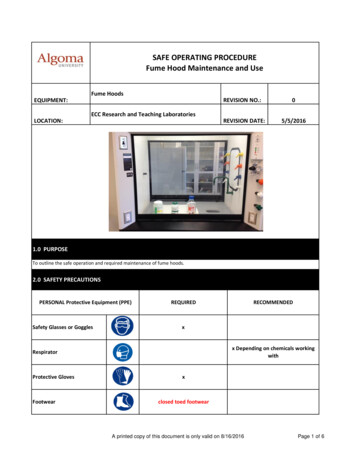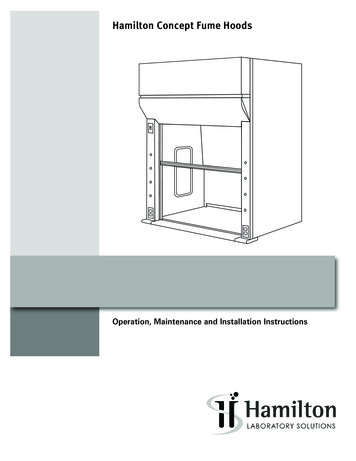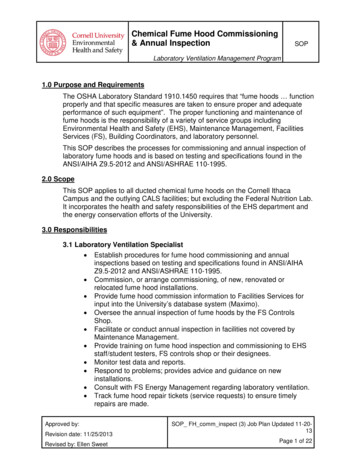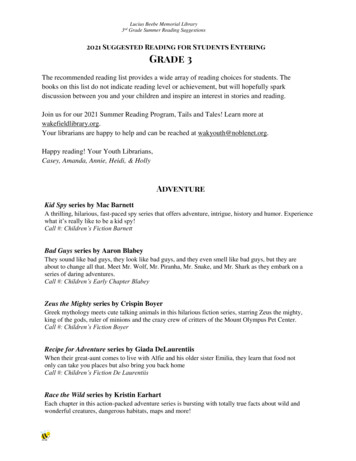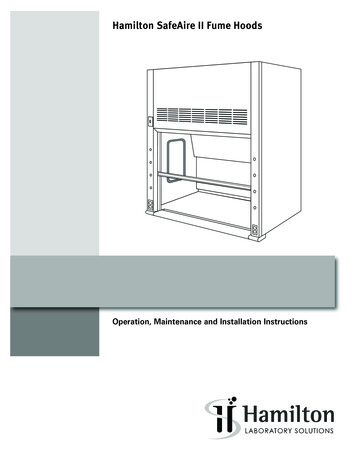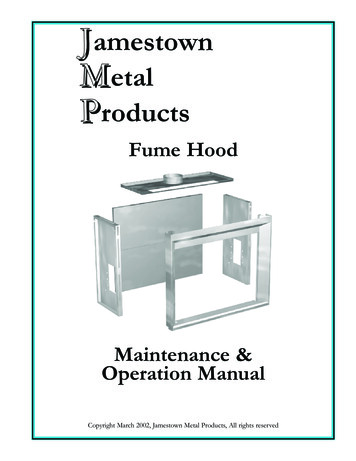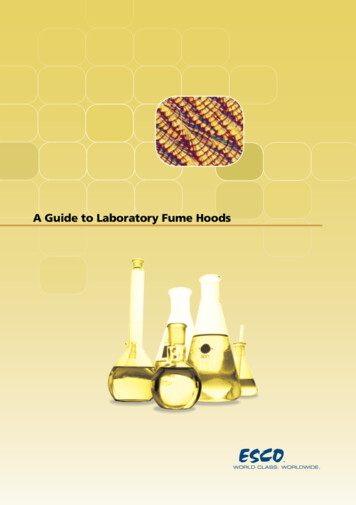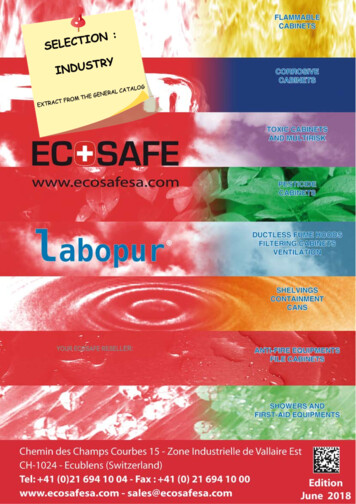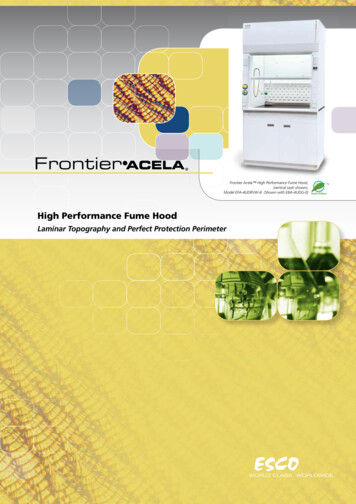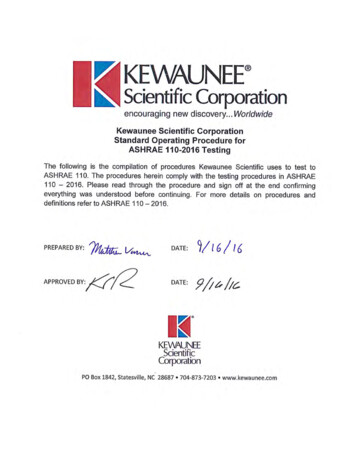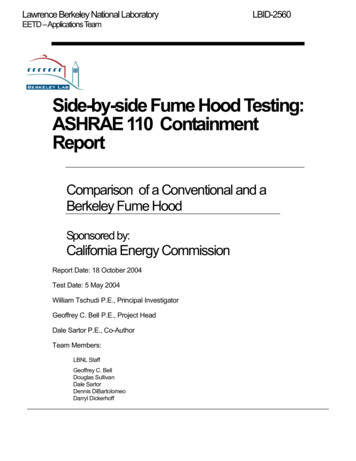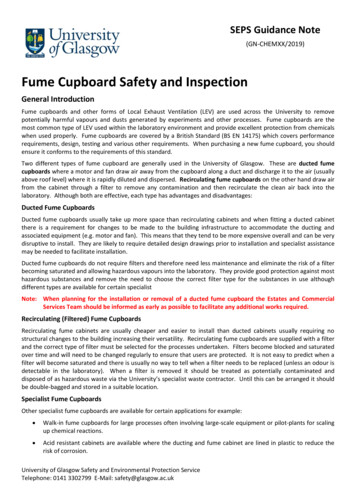
Transcription
SEPS Guidance Note(GN-CHEMXX/2019)Fume Cupboard Safety and InspectionGeneral IntroductionFume cupboards and other forms of Local Exhaust Ventilation (LEV) are used across the University to removepotentially harmful vapours and dusts generated by experiments and other processes. Fume cupboards are themost common type of LEV used within the laboratory environment and provide excellent protection from chemicalswhen used properly. Fume cupboards are covered by a British Standard (BS EN 14175) which covers performancerequirements, design, testing and various other requirements. When purchasing a new fume cupboard, you shouldensure it conforms to the requirements of this standard.Two different types of fume cupboard are generally used in the University of Glasgow. These are ducted fumecupboards where a motor and fan draw air away from the cupboard along a duct and discharge it to the air (usuallyabove roof level) where it is rapidly diluted and dispersed. Recirculating fume cupboards on the other hand draw airfrom the cabinet through a filter to remove any contamination and then recirculate the clean air back into thelaboratory. Although both are effective, each type has advantages and disadvantages:Ducted Fume CupboardsDucted fume cupboards usually take up more space than recirculating cabinets and when fitting a ducted cabinetthere is a requirement for changes to be made to the building infrastructure to accommodate the ducting andassociated equipment (e.g. motor and fan). This means that they tend to be more expensive overall and can be verydisruptive to install. They are likely to require detailed design drawings prior to installation and specialist assistancemay be needed to facilitate installation.Ducted fume cupboards do not require filters and therefore need less maintenance and eliminate the risk of a filterbecoming saturated and allowing hazardous vapours into the laboratory. They provide good protection against mosthazardous substances and remove the need to choose the correct filter type for the substances in use althoughdifferent types are available for certain specialistNote: When planning for the installation or removal of a ducted fume cupboard the Estates and CommercialServices Team should be informed as early as possible to facilitate any additional works required.Recirculating (Filtered) Fume CupboardsRecirculating fume cabinets are usually cheaper and easier to install than ducted cabinets usually requiring nostructural changes to the building increasing their versatility. Recirculating fume cupboards are supplied with a filterand the correct type of filter must be selected for the processes undertaken. Filters become blocked and saturatedover time and will need to be changed regularly to ensure that users are protected. It is not easy to predict when afilter will become saturated and there is usually no way to tell when a filter needs to be replaced (unless an odour isdetectable in the laboratory). When a filter is removed it should be treated as potentially contaminated anddisposed of as hazardous waste via the University’s specialist waste contractor. Until this can be arranged it shouldbe double-bagged and stored in a suitable location.Specialist Fume CupboardsOther specialist fume cupboards are available for certain applications for example: Walk-in fume cupboards for large processes often involving large-scale equipment or pilot-plants for scalingup chemical reactions. Acid resistant cabinets are available where the ducting and fume cabinet are lined in plastic to reduce therisk of corrosion.University of Glasgow Safety and Environmental Protection ServiceTelephone: 0141 3302799 E-Mail: safety@glasgow.ac.uk
Fume cupboards are available with wash-down facilities for projects where perchloric acid is regularly useddue to the highly reactive / explosive nature of this substance. Where equipment of this type is requiredspecialist advice should always be sought.General ConsiderationsWhen choosing a new fume cupboard there are many considerations that may affect the selection of equipment andthe manner of its installation. Consider the following: The depth and size of the working area should be sufficient to accommodate the equipment and tasks beingundertaken to reduce the risk of accidents. Some fume cupboards are available with transparent sides and rear panels. These are often used forteaching and demonstrations and can be an excellent way to allow students to witness a process before theytry it for themselves. They have the added advantage of improving sight lines in a laboratory making it morelikely that accidents or dangerous occurrences will be observed. Fume cupboards may be supplied with vertical or horizontal sashes (the former being more common).Consider the nature of the process and which type will provide users with the best protection. Some modern fume cupboards have work surfaces that are height-adjustable. This allows them to be usedcomfortably by staff and students with specific physical requirements. These tend to be more expensive butcan improve both accessibility and comfort for users. Identify which services may be required in the fume cupboard e.g. power, water, gas supplies etc. andensure that the cabinet purchased fulfil these requirements. Fume cupboards should be constructed of chemical resistant materials that are easy to clean e.g. stainlesssteel. Care should be taken to avoid surfaces likely to be damaged by the chemicals that will be used in thefume cupboard. The location of a fume cupboard can have a major effect on how well it operates. Many things can affect theefficiency of the air flow and hence the level of fume extraction achieved:oFume cupboards should be situated away from draughts, air conditioning systems etc. as these canaffect the efficiency of the air flow and introduce turbulence which could lead to harmful vapoursescaping from the cabinet.oHeated equipment can also cause turbulence and eddy currents within the cabinet increasing therisk of vapours escaping.oDucted fume cupboards constantly remove air from the laboratory which must be replaced. Thesource of “make-up air” should be considered and provisions made for this to avoid draughts andpressure changes which can lead to uncomfortable working conditions, turbulence etc.Note: Microbiological Safety Cabinets (MSC) and Laminar Flow Cabinets are not fume cabinets and will provideonly limited protection from hazardous chemical vapours. The correct type of cabinet should be used forthe main hazard associated with the process.Safety Tips and Operational GuidanceGeneral Safety Fume cupboards do not provide 100% protection to users, they do reduce significantly though dilution andextraction when used correctly. The use of fume cupboards is strongly encouraged when working withchemicals but forms only a part of a safe system of work. Fume cupboards will always be supplied with a user manual and guidance from the supplier. They shouldalways be installed, tested and operated in accordance with the manufacturer’s instructions. Most fume cupboards are easy to operate but all users should still take the time to familiarise themselveswith any safety features installed. New users should be trained by an appropriate person to work safely in afume cupboard.University of Glasgow Safety and Environmental Protection ServiceTelephone: 0141 3302799 E-Mail: safety@glasgow.ac.uk
Fume cupboards should be assigned a unique reference number such that they can be easily identified. Thisnumber should be prominently displayed and recorded clearly on any out of hours experiment forms. Many fume cupboards are supplied with ventilated cabinets underneath them. These cabinets can beconnected to the extraction system allowing any vapours to be removed form the cabinet. This is especiallyuseful for the storage of volatile substances. One of the main risks associated with fume cupboards (in particular ducted fume cupboards) is the risk of afire occurring within the working area and spreading into the associated ducting where it could causesignificant damage to the building. Consider the following when working with electrical equipment orflammable materials within a fume cupboard:oWhen flammable solvents or vapours are used in a process care should be taken to ensure that noignition sources are present in the same area. Electrical equipment should only be used in fumecupboards where there is no risk of a flammable atmosphere developing (normally the flow of airwill prevent this).oElectrical equipment used in fume cupboards should be regularly tested for electrical safety. Regularvisual safety checks should be carried out by users and any equipment that shows evidence ofoverheating or electrical faults should be removed from service.oPyrophoric substances should only be used after a stringent risk assessment and additional fireprecautions taken where necessary. Pyrophoric materials should be destroyed or rendered inertonce the process is completed.oOvernight experiments and processes involving electrical equipment and/or flammable substancesshould be fully risk assessed before they are undertaken and a procedure in place to highlight wherethese are being undertaken with information available to out of hours contacts and the securityteam.oWhere possible fume cupboards should be equipped with built-in fire suppression system that willdetect and react to a developing fire, quickly extinguishing with a suitable agent it before it spreads.oThe quantity of flammable solvents and other chemicals (including waste) stored in cabinets shouldbe minimised. Chemicals should only be present in a fume cupboard when they are in use and labwaste containers should be stored in fire resistant cabinets or external storage areas when full.Safe Operation of Fume Cupboards One of the key indicators that a fume cupboard is working properly is the face velocity (i.e. the speed of airmoving across the open part at the front of the cabinet). This should be clearly indicated on the front of thecabinet which should be equipped with a visual and audible warning in the event that the face velocity exitsthe acceptable working range.oFor most applications a face velocity of between 0.3ms-1 and 0.5ms-1 is desirable, if the face velocityis too low (below 0.3ms-1) the cabinet will not extract vapours effectively and if it is too high (above0.6ms-1) eddy currents will cause vapours to be released from the cabinet increasing the risk ofexposure. Fume cupboards should be cleaned regularly to avoid a build-up of contamination on surfaces.Housekeeping should also be considered as storage of equipment and other materials can block the bafflesat the rear of the cabinet reducing the efficiency of the cabinet, therefore storage in this area should belimited. In addition to making it harder to work safely clutter in the cabinet can also cause turbulent airflowreducing the level of containment achieved. Fume cabinets should not be used as storage areas ordumping grounds for waste or unwanted chemicals / equipment. To provide the best level of protection the front 15cm (6”) of the fume cupboard should be kept clear. Thishelps ensures that an adequate air flow is maintained and reduces the risk of spillages escaping from thefront of the fume cupboard and affecting the user. Some fume cabinets have this area clearly marked.University of Glasgow Safety and Environmental Protection ServiceTelephone: 0141 3302799 E-Mail: safety@glasgow.ac.uk
With pressures on space being highlighted across the university it is unsurprising that many fume cupboardsare regularly shared by two or more people. In general, it is impractical for more than two people to work inone cabinet at the same time. Care should be taken to ensure that only compatible processes are undertaken in a single fume cupboard.Communication is key where more than one user works in the same fume cupboard to avoid adversechemical reactions or interactions. Waste containers are often stored in fume cupboards to ensure any vapours generated are contained forextraction. While this is perfectly acceptable care should be taken not to block the baffles at the rear of thecabinet affecting the airflow or generating clutter in the cabinet. Where waste containers are presentsecondary containment should be considered to control leaks and spills. Where possible storage of waste invented cabinets underneath fume cupboards is preferable. In addition to helping to control the airflow the fume cupboard sash acts as a physical barrier between theuser and the chemical process taking place. The sash should always be kept in the correct position, ideallybetween the user and the process whenever possible. Users should avoid leaning into fume cupboards orplacing their head and shoulders inside when the fume cupboard is in use or chemicals are present. It is common practice in laboratories to place signs on fume cupboards and write on the sashes. Care shouldbe taken to keep this from restricting the user’s vision increasing the risk of an accident. Care should be taken when operating equipment used for heating (e.g. heating mantles, hotplates, ovensetc.) inside a fume cupboard. In addition to the increased fire risk the heat can affect the airflow inside thefume hood reducing its effectiveness. This does not mean that such equipment cannot be used in fumecupboards only that the possible reduction in efficiency should be considered in the risk assessment. Remember that just because a process is being carried out in a fume cupboard does not mean that thenormal PPE requirements in a laboratory can be ignored. In particular, the sash of the fume cupboard whileproviding some physical protection does not remove the need for safety glasses.Other Key Safety Information Before a fume cupboard can undergo significant maintenance, be moved from one laboratory to another orbe decommissioned at the end of its life it should be fully decontaminated. The method required willdepend on the precise nature of the chemicals handled but often a thorough clean with a detergent solutionwill be sufficient. Once decontamination has been completed the fume cupboard should be clearly labelledto confirm that it has been cleaned. The bevelled aerofoil at the front of the cabinet is an important design feature that helps to regulate theairflow and prevent turbulence which can reduce its effectiveness. The aerofoil should never be removed,damaged or modified by users. Many fume cupboards are equipped with services including electrical supplies, water and gas taps. Careshould be taken to avoid hanging PPE or other equipment on fume cupboard taps. While it is perfectly acceptable for empty chemical bottles to be left open in a ducted fume cupboard toallow any residue to evaporate this technique should not be used as a disposal method for larger quantitiesof volatile chemicals. These should be disposed of properly via the University chemical waste contractor. The vapours produced by certain malodourous chemicals (e.g. mercaptans and other stanching agents)should only be used in fume cupboards and even then, their use should be restricted to minimise theamount of time that containers open. Secondary containment is highly recommended when movingchemicals of this type to and from fume cupboards. Recirculating fume cupboards rely on the use of a suitable filter to remove hazardous vapours from the airbefore recirculating it into the laboratory. While filters can be very effective they have a limited lifespan andcan become saturated reducing their effectiveness. It is often difficult to tell when a filter is operating atreduced efficiency and it is strongly recommended that filters are changed regularly in accordance withUniversity of Glasgow Safety and Environmental Protection ServiceTelephone: 0141 3302799 E-Mail: safety@glasgow.ac.uk
suppliers’ guidelines. If it suspected that a filter has become saturated or the efficiency of the fume hoodappears reduced then it should be taken out of service until a new filter can be fitted.Note: Chemically contaminated filters from recirculating fume cupboards should be considered as chemicalwaste and should be safely contained for disposal via the University’s chemical waste contractor. Theyshould never be disposed of as general waste.Note: In the event of a power failure the extraction system will no longer operate if this occurs it isrecommended that the sash of all affected ducted fume cupboards is fully lowered if safe to do so. Thiswill allow some extraction to occur via the chimney effect. This technique is not effective for recirculatingfume cupboards.Inspection and Testing RegimeThorough Examination and Testing (TExT)It is a legal requirement under the CoSHH Regulations for all LEV systems (including fume cupboards) to undergo aThorough Examination and Test by a competent person at least every 14 months. In practice fume cupboardsbelonging to Units in the University of Glasgow are examined annually by an external contractor who carries out thefull examination and produces a report. These reports (and other related records) must be maintained for 5 yearsafter the inspection has been completed. However, as with all inspection reports tis simply confirms that the LEVsystem was fit for purpose at the time of inspectionNote: If a fume cupboard (or other LEV system) has not been inspected within the preceding 14-month period itmust not be used. This also applies to any fume cupboard that has failed the previous inspection untilappropriate repairs have been completed and the unit successfully retested.Regular User InspectionWe generally recommend that fume cupboards are regularly inspected by users to ensure that they are in goodcondition and remain fit for purpose between statutory inspections. Appropriate checks should be performed oneach fume cupboard by users on at least a monthly basis. Weekly checks are recommended for fume cupboardsthat are used for high risk substances. In support of this process a sample checklist has been produced by SEPS andis included in the appendix. Where user checks have been carried out, they should be formally recorded and anyremedial actions identified carried out in a timely manner.Further InformationFurther information on working safely in (and inspecting) fume cupboards can be obtained by contacting the Safetyand Environmental Protection Service. Note that this guidance document is specific to chemical fume cupboards andsome of the information will not apply to other equipment such as Microbiological Safety Cabinets (MSC) or LaminarFlow Cabinets.Additional information on fume cupboard safety can also be obtained from the HSE CoSHH Essentials guidance sheetG201 (Fume Cupboards), by consulting manuals and guidance from suppliers or within BS14175.General Office:Chemical Safety Adviser:0141 330 55320141 330 2799University of Glasgow Safety and Environmental Protection ServiceTelephone: 0141 3302799 E-Mail: safety@glasgow.ac.uk
Fume Cabinet Inspection ChecklistChecklist ItemYesNoNotes and observationsThorough Examination and Test completedwithin the previous 14-month periodAny signs of physical damage to the cabinet(internal or external)Cracking, damage or degradation of thesealant at the edges of the cabinetSash moves smoothly through full rangeand remains in position when releasedFume cupboard sash clear and not obscuredwith writing or signs.Alarm is operational (visual and audible)when sash raised above safety pointSash high position restrictor in place andfunctioning properlyAir flow reading indicator present andworking correctly (note air flow reading)Cabinet lights (where present) arefunctioningWater supply to cabinet (where present)working and flushed for 2 minutes.Gas supply (where present) operationalwith no evidence of leakageRecirculating filter present and changedwithin supplier guidelinesVisible ductwork associated with cabinet ingood condition with no obvious breachesGood housekeeping with no restriction toair flow at the rear of the workspaceSurfaces reasonably clean and free ofcontaminationDebris or detritus present on the ventilationgrille / baffles at rear of the cabinetSecondary containment of waste containersand other stored liquidsFume Hood LocationFume Hood ReferenceInspector NameDate of InspectionUniversity of Glasgow Safety and Environmental Protection ServiceTelephone: 0141 3302799 E-Mail: safety@glasgow.ac.uk
Note: Microbiological Safety Cabinets (MSC) and Laminar Flow Cabinets are not fume cabinets and will provide only limited protection from hazardous chemical vapours. The correct type of cabinet should be used for the main hazard associated with the process. Safety Tips and Operational Guidance General Safety
